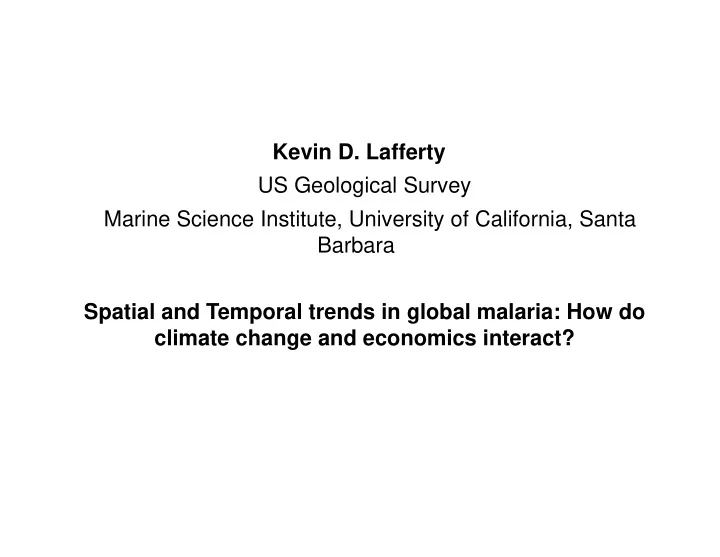

Kevin D. Lafferty US Geological Survey Marine Science Institute, University of California, Santa Barbara Spatial and Temporal trends in global malaria: How do climate change and economics interact?
Why Malaria? Largest source of mortality in tropical developing nations, particularly for children. Impairs economic development. Sensitive to climate (and climate change).
A few malaria facts Caused by a protozoan that infects blood. Three species, with Plasmodium falciparum being the most dangerous. Control efforts include: Mosquito control: wetland destruction, poisons, biological control Preventative medicines (for travelers) Treatment with chemotherapy Vaccines? Unlikely
Temperature response Climate projection artens et al. 1995
Process-based model for changes in malaria Present Contraction Expansion 2025 2055 2085 Thomas et al. 2004
Statistical-based malaria projection Rogers and Randolph 2000 Science
How has disease responded to climate change? 0.6 0.5 0.4 m ean global tem perature ( dev) 0.3 0.2 40 0.1 0 -0.1 -0.2 -0.3 20 -0.4 1900 1920 1940 1960 1980 2000 Year mean global temp (dev) % global area malaria
Contraction of malaria over time Hay et al. 2004 Lancet
How has disease responded to climate change? 0.6 0.5 0.4 m ean global tem perature ( dev) 0.3 0.2 40 0.1 0 -0.1 -0.2 -0.3 20 -0.4 1900 1920 1940 1960 1980 2000 Year mean global temp (dev) % global area malaria
How has disease responded to climate change? 55 15 50 10 % global m alaria ( detrended) 45 5 40 0 35 -5 30 -10 25 -15 -0.25 -0.05 0.15 0.35 0.55 Tem perature ( decadal global m ean dev)
How has disease responded to climate change? 55 15 50 10 % global m alaria ( detrended) 45 5 40 0 35 -5 30 -10 25 -15 -0.25 -0.05 0.15 0.35 0.55 Tem perature ( decadal global m ean dev)
Land-use change and malaria reduction in Britain Kuhn et al. 2003 PNAS
Questions • Why has malaria contracted from some regions but not others? • Hyp 1: economics (treatment, habitat destruction, vector control, indoor living) • Hyp 2: climate (temperature & precipitation) • How Can GPD cancel out climate? • How much will climate change override current economic effects?
Approach • Develop a statistical model that explains changes in the temporal and spatial distribution of malaria at a global scale. • Malaria Data: Lysenko Map for historical data, plus new maps for current data. Spatial resolution varies due to reporting. • Climate data: lots • Economic data: Spatial only to country level. • Can we do better than using nations as replicates?
How to incorporate space?
Neuroticism increases with Toxoplasma prevalence Lester residuals NEO-PI-R 3 Anxious, depressed, self-conscious, R 2 = .30 2.5 impulsive, vulnerable 2 1.5 1 0.5 0 -0.5 -1 Relaxed, confident, -1.5 secure, optimistic -2 0 10 20 30 40 50 60 70 National prevalence of T. Especially facets of vulnerability and impulsiveness Lafferty 2006 PRSL
Present conditions, Hay et al. 2009 QuickTime™ and a decompressor are needed to see this picture.
1995 Per capita GDP
Current rainfall and precipitation
Next steps Define collaboration Specify hypotheses Determine statistical model Obtain spatial and temporal data Analyze Write Lafferty@lifesci.ucsb.edu
Recommend
More recommend